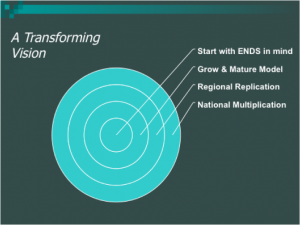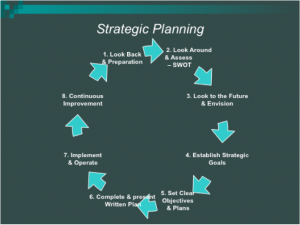Article IX: A Strategic Plan to Reach an Entire Metropolitan Area or a Region
I propose an orderly roll out of a strategic plan to reach an entire metropolitan area or a region by starting, growing, maturing, replicating and multiplying communities of teachers and learners through classical Christian schools. These slides illustrate the process while the outline makes the proposal clear.

1. Starting: Open a school location no matter how large or small.
1.1. Assemble a core launch group of like-minded people that share the common goal of starting a school of a particular kind.
1.2. Raise necessary start up capital and operate in the black on the basis of tuition and fees as soon as possible if not in the first year.
1.3. Do all the preparation work from establishing a non-profit, to developing brand/identity logo, finding facilities, marketing and recruiting, faculty, staff and families.
1.4. Establish a core curriculum program for the development of the Christian mind for a selective group of qualified teachers, students and parents that are committed to the ends established. Focus – major on this major before branching out. Do first what only you can do best in your region.
1.5. Open the doors.
1.6. Add arts, athletics and leadership opportunities to enrich the learning and growing experience without departing from the mission to develop Christian liberal artists.
2. Growing: Seek to grow the first school location in quality and enrollment
2.1. Pursue qualitative development and continuous improvement through accreditation
2.2. Add all grades Pre-K-12 as demanded and while maintaining quality
2.3. Fill out each grade section to established capacity
2.4. Adjust tuition accordingly to assure solvency, respectable compensation for faculty and staff, tuition assistance and the beginning of a surplus
3. Maturing: Financial stability, property acquisition and program expansion to enrich a broader constituency
3.1. Develop and implement a financial plan that sustains the financial health of the Academy and is aligned with the mission and strategic direction.
- 3.1.1. Budget to operate on hard income. Meaning pay all the schools expenses with tuition and fees without subsidizing with donated funds.
- 3.1.2. Assure a current ratio (ration of current assets to current liabilities) of at least 1:1
- 3.1.3. Build unrestricted reserves sufficient to weather an unanticipated financial need.
- 3.1.4. Build an operating budget process that anticipates and responds to fluctuations in the economy.
- 3.1.5. Grow academy funding through innovative approaches to program development consistent with its mission that generate net ordinary income
- 3.1.6. Diversify funding by developing an internal culture of philanthropy to be used to start new programs, support tuition assistance, etc. but not for operating expenses
- 3.1.7. Launch a capital campaign to purchase or build a permanent campus
- 3.1.8. Develop outside philanthropic resources to fund growth and replication for the sake of the community or region at large
3.2. Purchase and develop a physical campus to communicate permanence and provide a multi faceted learning environment conducive to the mission of the academy.
3.3. Expand programming for enrolled students
- 3.3.1. Add a flexible schedule that allows students to attend part time or full time while receiving the same rich education.
- 3.3.2. Add a study center to provide for flexibility in scheduling, advanced learning, and tutoring
- 3.3.3. Add an @ home option
- 3.3.4. Add summer and after school Pre-K-12 programs for enrolled and non-enrolled students
3.3.4.2. Accelerated academic programs for students that desire to graduate early and so forth
3.3.4.1. Arts, athletics, college entrance prep, tutoring, and other desirable programs
3.4. Expand programming for students not enrolled at the Academy by developing campus services to the community that increase the academy’s Christian influence while augmenting income and responsibly stewarding campus resources. Employ a business plan to put the campus to use profitably while consistent with the academy’s mission. These programs will operate in the summer, after school and on the weekends consistent with the needs of these new families.
- 3.4.1. Retain a separate head for developing these programs that reports to the Headmaster like any other division head
- 3.4.2. Add expanded conditioning and athletic programs and summer sports camps and select teams
- 3.4.3. Add a theatre company, school of visual arts and music to serve the community. This will work especially well as specialty spaces for these programs are constructed. One could purchase an existing music or arts schools complete with a customer base in order to jump start expansion.
- 3.4.4. Provide unique programs such as Latin, great books, progymnasmata, logic and rhetoric, Bible, theology and apologetics as well as programs in the sciences from a creationist perspective to serious students attending other schools.
- 3.4.5. Add a tutorial center that can compete with Sylvan, Kumon etc. yet with a Christian world and life view
- 3.4.6. Allow a church to enjoy the facilities while advancing the Gospel and serving the community
- 3.4.7. Operate the completed campuses as conference centers
3.5. Reach adults in the primary (parents of enrolled students) and secondary (grandparents) school constituencies and the broader community with unique learning opportunities in the liberal arts to reach two or even three generations at once. These programs operate after school and on the weekends when the primary academy constituency is not intensively using the campus.
- 3.5.1. Great Books discussion groups with and without graduate level college credit
- 3.5.2. Biblical worldview
- 3.5.3. An overview of Western Civilization
- 3.5.4. A Latin primer etc.
3.6. Whereas points 1 and 2 operate almost entirely based on tuition and fees section 3 adds business income and a well-developed culture of philanthropy. The basic school operation should still operate in the black. Business income and philanthropy provide for physical development of the campus and the outward impulse of program growth
4. Replicating: Start satellite schools imitating the successful model of the first school.
4.1. Establish satellite campuses according to the pattern in points 1 – 3 under the same school name and corporate status in an established service region.
4.2. Raise start up capital for each new school start and then operate based on tuition and fees.
4.3. After developing through stages one and two, purchase property and move into stage three as the Lord provides and demand warrants.
4.4. After much deliberation you may decide to transfer the work of establishing additional campuses to a separate company in order to allow the Academy to concentrate its entire effort on schooling. The idea is to develop an outward and upward impulse to reach and entire region through the educational model employed. A single school is good, while reaching an entire region is great.
Upcoming Articles:
The Strategic Academy Assessment and Action Plan
Leadership Agility
And many more

